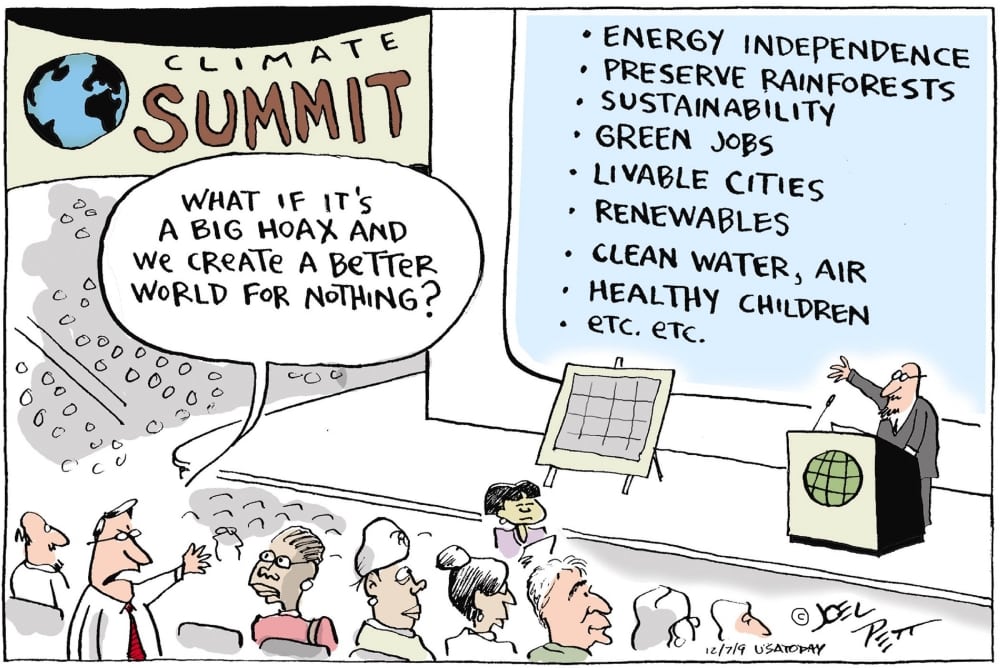 According to the best science available, based on a method of inquiry that has served civilization for centuries, the earth’s climate will continue to heat up at a pace never before recorded. This may not change our lives so much, but our children and grandchildren are in for a wild ride. We can slow down the warming, but it will take a tremendous, sustained effort over generations, because climate change due to increasing amounts of carbon dioxide trapped in the atmosphere appears to be accelerating so fast it has its own momentum.
According to the best science available, based on a method of inquiry that has served civilization for centuries, the earth’s climate will continue to heat up at a pace never before recorded. This may not change our lives so much, but our children and grandchildren are in for a wild ride. We can slow down the warming, but it will take a tremendous, sustained effort over generations, because climate change due to increasing amounts of carbon dioxide trapped in the atmosphere appears to be accelerating so fast it has its own momentum.
When the planet’s health was easier to see and comprehend — smog, acid rain, the polluted Hudson — politicians from both parties worked together to find solutions. But this danger is distant, and complex, with uncertain outcomes. And somewhere along the way scientists — thousands of scientists, in multiple disciplines — have become cast by naysayers as clueless villains who hope for unexplained reasons to destroy the economy by sabotaging the most profitable product ever devised: fossil fuels dug from the earth.

There is a clear and consistent divide between the two major parties on global warming that extends right down to our own Congressional district. According to research using 2018 data in the journal Climatic Change that examined different views of climate change at the local level, 92 percent of Democrats in the 18th are convinced global warming is happening, but only 58 percent of Republicans. More than 88 percent of Democrats say they are concerned, versus 49 percent of Republicans.
Fred Rich, a Garrison resident who is the author of Getting to Green, a book that outlined (before President Trump) how the parties might find common ground on environmental issues, argues that polls are skewed by the third of Republicans who are hardcore deniers. Results also vary by state: Republicans in New York, Delaware and Alaska are more likely to believe that rapid climate change is underway than Republicans elsewhere.
In this, the fifth and final part of our series, we spoke with Rich and other Highlands residents who are doing what they can to get things moving. New York State has promised grants to communities that mitigate and adapt for what is coming, but only Philipstown has made much progress. Passionate activists such as Krystal Ford in Garrison and members of the newly formed chapter of the Citizens’ Climate Lobby in Beacon are attempting to add urgency to the conversation. But it’s a hard sell, and politicians think in terms of two to eight years, not 50 to 100. Fred Rich points out that people respond better to hope than gloom. So, where is it?
Climate Smart
The Bottom Line
Can We All Get Along?
Hot Earth, or Hot Air?
The Series
Part 1: Runaway Train (May 4)
Part 2: Rising Waters (May 11)
Part 3: Farm = Food (May 25)
Part 4: Into the Wild (June 1)


Outstanding series! Thanks to Chip Rowe, Brian PJ Cronin, and all the participants. Our little Highlands Current coverage of this monumental crisis is far superior to most major news outlets. It was especially inspiring to learn of the brilliant, caring people in our community engaged in the effort to help save us from ourselves.
Your series on climate change in the Highlands reminded me of an event in April when the Philipstown Climate Smart Communities Task Force invited people to the Desmond-Fish Library to tell “climate-change stories.”
Severe storms and the unpredictability of the weather were a common thread. One woman spoke of her fear while driving her car under a tree which was lying on top of a power line. For many other people in the audience, there was the fear of not knowing what to expect.
After 31 years living in Philipstown, it was surprising to me how easily it all seemed to boil down to one nasty word: Ticks! I lived at the Taconic Outdoor Education Center for two years in the late 1980s and spent a lot of time in the woods, and I only recall two or three ticks in that entire time, and they were dog ticks, not deer. The awful scourge that has blossomed is likely due to a warming climate.
The questions asked during the discussion were largely formulated by an organization called Climate Change Stories. The local organizer, Krystal Ford, played audio clips recorded by visitors to the group’s website. One observer who lived in the Adirondack North Country spoke sadly of the variability of good ice for pond hockey and ice-fishing.
We would like to hear from others in the Philipstown area as to what changes they’ve seen and what their emotional responses have been, as well as how they imagine the future, and what they think can be done to mitigate the situation. Visit climatestoriesproject.org to participate.